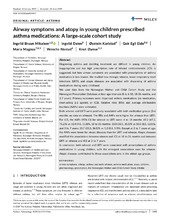Airway symptoms and atopy in young children prescribed asthma medications: A large‐scale cohort study
Mikalsen, Ingvild Bruun; Dalen, Ingvild; Karlstad, Øystein; Eide, Geir Egil; Magnus, Maria Christine; Nystad, Wenche; Øymar, Knut
Peer reviewed, Journal article
Published version

Åpne
Permanent lenke
https://hdl.handle.net/1956/22157Utgivelsesdato
2019Metadata
Vis full innførselSamlinger
Originalversjon
https://doi.org/10.1002/ppul.24437Sammendrag
Diagnosing asthma and deciding treatment are difficult in young children. An inappropriate and too high prescription rate of inhaled corticosteroids (ICS) is suggested, but how airway symptoms are associated with prescriptions of asthma medication is less known. We studied how strongly wheeze, lower respiratory tract infections (LRTI), and atopic diseases are associated with dispensing of asthma medications during early childhood. We used data from the Norwegian Mother and Child Cohort Study and the Norwegian Prescription Database at four age‐intervals (0‐6, 6‐18, 18‐36 months, and 3‐7 years). Primary outcomes were dispensed asthma medications (no medication, short‐acting β‐2 agonist, or ICS). Relative risks (RRs) and average attributable fractions (AAFs) were estimated. Both wheeze and LRTI were positively associated with both medication groups (0‐6 months: no data on wheeze). The RRs and AAFs were higher for wheeze than LRTI. For ICS, the AAFs (95% CI) for wheeze vs LRTI were: 6 to 18 months: 69.2 (67.2, 71.2)% vs 10.4 (9.0, 11.8)%, 18 to 36 months: 33.0 (30.5, 35.5)% vs 10.0 (8.0, 12.0)%, and 3 to 7 years: 33.7 (31.0, 36.5)% vs 1.2 (0.5, 1.9)%. Except at 3 to 7 years of age, the AAFs were lower for atopic diseases than for LRTI and wheeze. Atopic diseases modified the associations between wheeze and ICS at 18 to 36 months and between LRTI or wheeze and ICS at 3 to 7 years. In conclusion, both wheeze and LRTI were associated with prescriptions of asthma medications in young children, with the strongest associations seen for wheeze. Atopic diseases contributed to these associations only in the oldest age groups.
